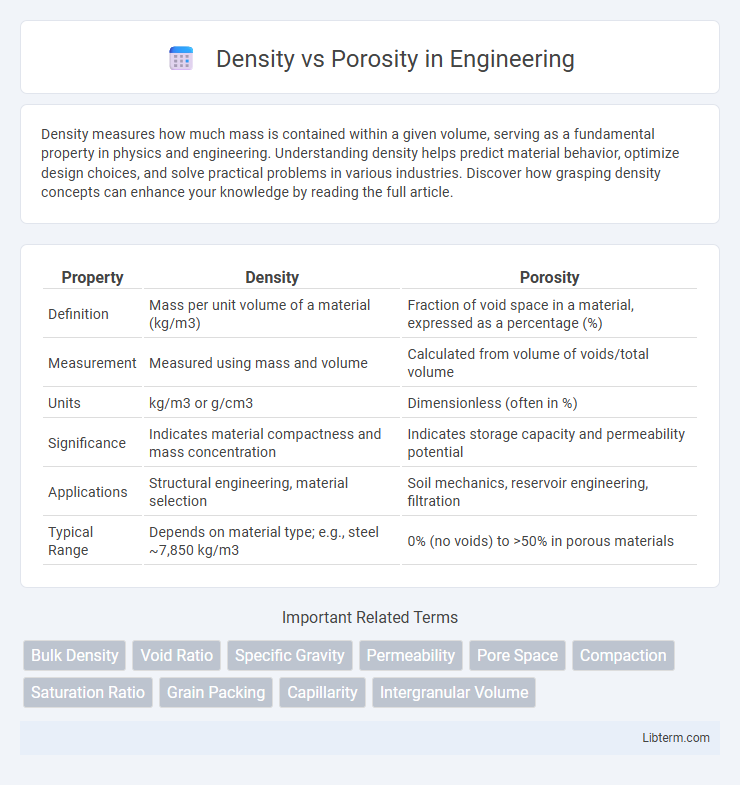Density measures how much mass is contained within a given volume, serving as a fundamental property in physics and engineering. Understanding density helps predict material behavior, optimize design choices, and solve practical problems in various industries. Discover how grasping density concepts can enhance your knowledge by reading the full article.
Table of Comparison
| Property | Density | Porosity |
|---|---|---|
| Definition | Mass per unit volume of a material (kg/m3) | Fraction of void space in a material, expressed as a percentage (%) |
| Measurement | Measured using mass and volume | Calculated from volume of voids/total volume |
| Units | kg/m3 or g/cm3 | Dimensionless (often in %) |
| Significance | Indicates material compactness and mass concentration | Indicates storage capacity and permeability potential |
| Applications | Structural engineering, material selection | Soil mechanics, reservoir engineering, filtration |
| Typical Range | Depends on material type; e.g., steel ~7,850 kg/m3 | 0% (no voids) to >50% in porous materials |
Understanding Density and Porosity
Density measures the mass of a material per unit volume, reflecting how compact the particles are within a substance. Porosity quantifies the percentage of void spaces or pores in a material, indicating the capacity to hold fluids or gases. Understanding the relationship between density and porosity is essential in fields like geology, material science, and engineering, where these properties influence material strength, permeability, and functionality.
Definitions: What Are Density and Porosity?
Density measures the mass of a material per unit volume, reflecting how compact the particles are within a substance. Porosity quantifies the percentage of void spaces or pores in a material, indicating how much empty space exists relative to the total volume. Understanding the difference between density and porosity is crucial in fields like geology, materials science, and engineering for analyzing material properties and behavior.
The Relationship Between Density and Porosity
Density and porosity are inversely related properties in materials science, where increased porosity typically results in decreased density due to the higher volume of void spaces within the material. Porosity measures the fraction of void or empty space in a material, while density quantifies the mass per unit volume, including both solid material and pores. Understanding this relationship is critical in applications such as soil mechanics, rock analysis, and construction materials, where controlling porosity affects strength, permeability, and overall material performance.
Factors Affecting Density in Materials
Density in materials is influenced primarily by atomic mass and the packing arrangement of atoms or molecules within the structure. Factors such as temperature, pressure, and material composition significantly affect density values by altering the spacing and bonding between particles. Porosity inversely impacts density by introducing void spaces that reduce the overall mass per unit volume in porous materials.
Factors Influencing Porosity
Porosity is influenced primarily by grain size, sorting, and cementation within a rock formation, where well-sorted grains with minimal cementation result in higher porosity. Density affects porosity indirectly, as denser materials generally exhibit lower pore space due to tighter packing of particles. Diagenetic processes and compaction further modify porosity by reducing pore volume and increasing bulk density over time.
How Density Impacts Material Strength
Density significantly impacts material strength by determining how closely packed the atoms or molecules are within a substance, resulting in greater resistance to deformation and higher load-bearing capacity. Materials with higher density typically exhibit increased tensile and compressive strength due to the reduced presence of voids, which enhances their structural integrity. Porosity inversely affects strength by introducing voids or pores, but materials with optimized density minimize these defects, leading to improved mechanical performance and durability.
The Role of Porosity in Material Behavior
Porosity significantly influences material behavior by determining its capacity to store fluids and affecting mechanical strength. High porosity generally reduces density and lowers the material's load-bearing ability, impacting properties like permeability and thermal insulation. Understanding porosity helps optimize applications in fields such as geotechnical engineering, ceramics, and reservoir characterization.
Measuring Density and Porosity: Common Methods
Measuring density typically involves using the mass-to-volume ratio, with techniques like water displacement for solids and pycnometry for powders offering precise volumetric data. Porosity measurement commonly employs methods such as mercury intrusion porosimetry, gas adsorption, and micro-computed tomography, which provide detailed insights into pore size distribution and total pore volume. Advanced techniques like nuclear magnetic resonance (NMR) and helium pycnometry enhance accuracy by capturing connected versus isolated porosity, critical for evaluating material permeability and structural integrity.
Applications of Density and Porosity in Industry
Density influences material selection in industries like aerospace and automotive, where lightweight yet strong components are essential. Porosity is critical in filtration, ceramics, and construction, affecting material strength, permeability, and insulation properties. Both density and porosity measurements guide quality control, optimizing product performance and durability in manufacturing processes.
Comparing Density and Porosity: Key Takeaways
Density measures the mass of a material per unit volume, indicating how compact its particles are, while porosity quantifies the percentage of void spaces within a material's total volume, reflecting its ability to hold fluids. High density often correlates with low porosity since tightly packed particles leave fewer voids, but exceptions exist depending on material composition and structure. Understanding the inverse relationship between density and porosity is essential for applications in geology, construction, and material science to predict strength, permeability, and durability.
Density Infographic

 libterm.com
libterm.com